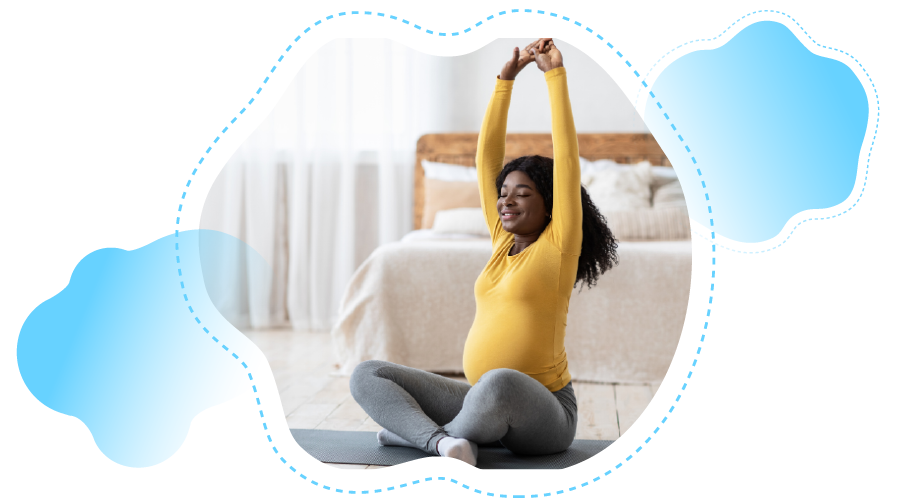Physical activity during pregnancy is safe and is essential for the good health and wellbeing of both you and your baby (1). To optimise these health benefits current physical activity guidelines recommend you accumulate at least 150-300 minutes of moderate-vigorous intensity activity per week (2).
If you and your baby are healthy, physical activity is safe for you. In some pregnancies, women may experience medical and obstetric conditions that may mean physical activity may not be safe including:
• Incompetent cervix • Ruptured membranes, preterm labour • Persistent second or third trimester bleeding • Placenta previa • Pre-eclampsia • Evidence of intrauterine growth restriction • Multiple gestation (triplets or higher number) • Poorly controlled Type 1 diabetes, hypertension or thyroid disease • Other serious cardiovascular, respiratory or systemic disorder
If you have been diagnosed with any of the above conditions, you should consult your health professional for appropriate physical activity guidance.

What is the right amount of activity for me?
Previously inactive women are encouraged to participate in physical activity during pregnancy; they are advised to start slowly and gradually progress towards meeting the guideline recommendations (3, 4).
“It is never too late to start, irrespective of your physical activity behaviours pre-pregnancy. Physical activity in accordance with the guidelines is not associated with miscarriage, stillbirth, neonatal death, preterm birth, preterm/prelabour rupture of membranes, neonatal hypoglycaemia, low birth weight, birth defects, induction of labour or birth complications.”
Previously active women are encouraged to continue with their activities in accordance with the guideline recommendations. Activity modifications may be required as pregnancy progresses.
Previously highly active women (including women who are already exceeding the amount of physical activity described in the guidelines), may continue with their activity, but should modify their activities as their pregnancy progresses, with advice from an informed health professional.
How often should I be active?
As often as possible, remember that all movement is considered activity! Your recommended weekly activity should preferably be accumulated across most, if not all days of the week. Look for opportunities throughout the day to increase your activity and aim to break up long periods of sitting and/or standing still. For instance, hang the washing out instead of using a dryer, use the stairs instead of the lift, use a smaller cup which means you need to refill it more often, park the car further away and walk the last leg of your journey or hop off the bus one stop earlier.
Importantly, if you are active, it means you are not sedentary (e.g., sitting down for extended periods of time), and this matters because sedentary behaviours are associated with negative health outcomes.
How do I measure the intensity of my activity?
The best way to measure your intensity during activity is by using the ‘Talk Test’. You should be able to carry on a conversation during moderate intensity activity, but you would find this difficult during vigorous intensity activity.
What types of activity can I do?
All types of activity count! Your activity can consist of anything from hanging washing out to taking a stroll around the neighbourhood, to performing some bodyweight exercise whilst watching your favourite TV show, to playing your weekly game of sport.
Ideally, your weekly activity will consist of aerobic activity (e.g., walking, swimming, cycling, dance) and at least 2 sessions of resistance-based activity (e.g., bodyweight, resistance bands, weights).
“Yes, that’s correct – resistance training IS recommended during pregnancy. Not only does it help to keep your body strong, resistance training during pregnancy may also help to reduce the severity of musculoskeletal discomfort (e.g., low back and pelvic girdle pain) as pregnancy progresses.”
You should also aim to do pelvic floor exercises every day to keep your pelvic muscles strong and avoid problems like incontinence.
Generally speaking, you can continue to participate in the same activities as you did pre-pregnancy. However, you may need to modify some of these activities as your pregnancy progresses.
There are also some activities that you SHOULD NOT participate in during pregnancy. These activities include those that involve a high risk of falling or collision, repeated heavy lifting and/or significant changes in pressure (such as sky diving or scuba diving). You should not engage in any activity that causes any pain or discomfort.
Don’t forget to stay well hydrated and avoid activity in hot weather, especially in high humidity and always wear appropriate shoes, non-restrictive clothing and a supportive bra.
When should I return to activity after pregnancy?
The timing of return to physical activity following childbirth is highly variable. A gradual return to recommended levels of physical activity is considered to be safe after the six week postnatal check. We also encourage all women be assessed by a pelvic health specialist / women health physiotherapist as they are qualified to assess, treat and manage conditions related to pregnancy, including pelvic floor dysfunction, pelvic girdle pain and other musculoskeletal conditions. They can then provide you with specific and individualised exercise prescription.
Pelvic floor exercises (several times each day) should be commenced as soon as is comfortable following the birth, and continued for life.
“Breastfeeding is not negatively impacted by physical activity. Ensure that you wear a bra that provides adequate support during activity. TIP: Feeding or expressing milk before activity may reduce discomforts associated with full breasts during activity.”
For women who wish to return to training and competitive sport, depending on the individual case, more intense activities can be gradually resumed, building from moderate to vigorous physical activity over a period of about three months. A gradual approach is recommended as returning to high intensity and/or high volume activity too soon following birth may increase the risk of injury (5).
About the author
Melanie Hayman is an Associate Professor in the School of Health, Medical, and Applied Sciences at CQUniversity. Her research focuses on exercise during pregnancy and return-to-sport postpartum. Dr Hayman’s most notable research to date includes the authorship of the 2021 Australian Physical Activity Screening Tool for pregnant women, the 2020 Evidence-based physical activity guidelines for pregnant women (on behalf of the Australian Government) and various factsheets for elite athletes during pregnancy and postpartum in partnership with the Australian Institute of Sport (AIS). She is currently working with both the QLD Academy of Sport (QAS) and AIS to develop Australian guidelines to support elite female athletes during pregnancy and in their return-to-sport postpartum.

References
- Brown W, Hayman M, Haakstad L, et al. Evidence-based physical activity guidelines for pregnant women: Report for the Australian Government Department of Health, March 2020. Canberra: Australian Government Department of Health; 2020.
- Brown WJ, Hayman M, Haakstad LAH, et al. Australian guidelines for physical activity in pregnancy and postpartum. Journal of Science and Medicine in Sport 2022; 25(6):511-9.
- Mottola M, Davenport M, Ruchat S, et al. 2019 Canadian guideline for physical activity throughout pregnancy. British Journal of Sports Medicine 2019; 52(21):1339-46.
- Davenport M, Kathol A, Mottola M, et al. Prenatal exercise is not associated with fetal mortality: a systematic review and meta-analysis. British Journal of Sports Medicine 2019; 53:108-15.
- Kimber ML, Meyer S, McHugh T-L, et al. Health Outcomes following Pregnancy in Elite Athletes: A Systematic Review and Meta-analysis. Med Sci Sports Exerc 2021.
The Activate Your Everyday Series is proudly supported by the Queensland Government and Health and Wellbeing Queensland through ActiveKIT Round 2
